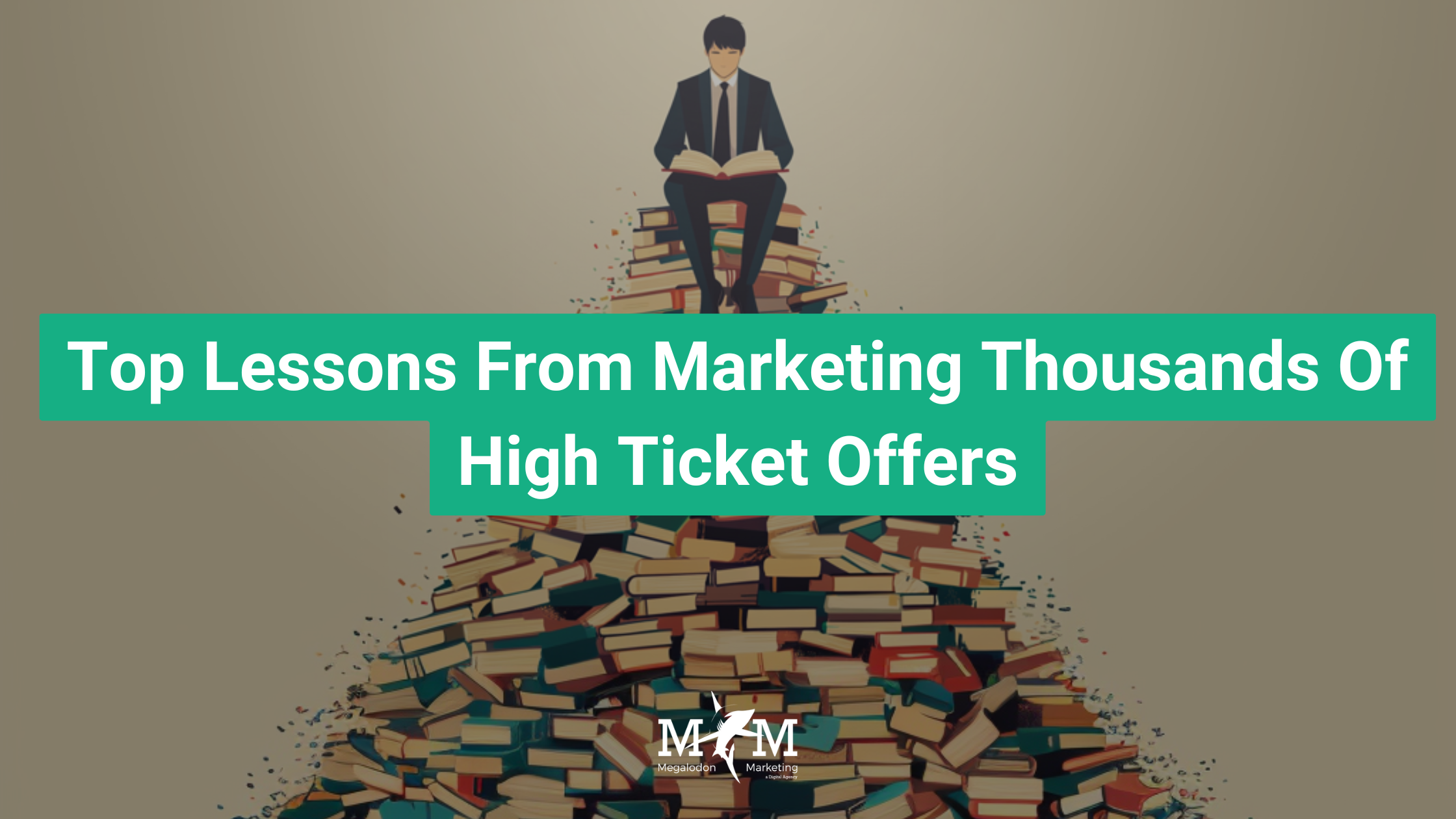I hope you enjoy reading this blog post. If you want my team to just do your marketing for you, click here.

I hope you enjoy reading this blog post. If you want my team to just do your marketing for you, click here.
Author: Jeremy Haynes | founder of Megalodon Marketing.

Earnings Disclaimer: You have a .1% probability of hitting million dollar months according to the US Bureau of Labor Statistics. As stated by law, we can not and do not make any guarantees about your own ability to get results or earn any money with our ideas, information, programs or strategies. We don’t know you and, besides, your results in life are up to you. We’re here to help by giving you our greatest strategies to move you forward, faster. However, nothing on this page or any of our websites or emails is a promise or guarantee of future earnings. Any financial numbers referenced here, or on any of our sites or emails, are simply estimates or projections or past results, and should not be considered exact, actual or as a promise of potential earnings – all numbers are illustrative only.
Scaling a high-ticket business to million-dollar months isn’t for the faint of heart. It requires precision, discipline, and a deep understanding of what drives success. Having worked with thousands of high-ticket offers, I’ve learned the patterns that separate businesses that merely survive from those that thrive. This article is a culmination of those lessons—a roadmap to achieving sustainable, scalable success.
Let’s dive in.
The first and most critical lesson is having a standout offer. A standout offer isn’t just a catchy tagline or flashy marketing. It’s a solution that resonates deeply with your target audience, creating high demand and low resistance.
Take real estate as an example. Most people already believe that real estate creates wealth. This pre-existing belief reduces the effort required to convince potential buyers. Contrast this with a niche offer like earning passive income through payment processors. Without a pre-existing narrative, you face an uphill battle of building awareness and overcoming skepticism.
To create a standout offer, ensure your audience already has thoughts or a high demand for your solution. Leverage existing beliefs or desires. If they don’t, rework the offer or prepare for a much steeper climb. Ask yourself, Does my audience already understand and value what I’m offering? If the answer isn’t a resounding yes, you’ve got work to do.
In-market demographics are the low-hanging fruit for scaling. These are people who actively identify with the problem your product solves or desire the solution you offer.
For example, if your audience is in commercial real estate, they likely already believe in real estate as a wealth-building tool. This belief makes them more receptive to offers, reducing the effort needed to close deals. On the flip side, targeting a less educated or unaware demographic will cost you significantly more time and money. This is why the demographic’s mindset is critical—you can’t force someone to care about your solution if it’s not already on their radar.
If you’re struggling to find in-market buyers, refine your targeting. Dive deeper into your audience’s beliefs, desires, and pain points. Build messaging that speaks directly to those already searching for what you provide. The easier the sale feels, the closer you are to unlocking exponential growth.
Accumulation mode is a critical phase during scaling. It involves setting aside profits while reinvesting intelligently into growth. It’s about playing the long game while scaling aggressively.
Failing to accumulate often leads to razor-thin margins and a constant state of survival. Businesses stuck in this cycle can only risk the same amount monthly, limiting their growth potential. When you’re not building a buffer, every setback feels catastrophic. Scarcity kills innovation and momentum—don’t let it happen to you.
Set clear accumulation goals each month. Split profits between reinvestment and savings, ensuring you’re always prepared for the next phase of growth. This approach keeps your business on solid ground while fueling the next level of scale.
Relying on a single conversion mechanism is one of the riskiest positions a business can be in. While scaling what works is essential, diversification is equally critical.
For instance, one client scaled from $200K to $2.5M per month relying heavily on one ad channel and one funnel. However, they wisely diversified before that channel faced disruptions. When the channel went down, their diversified revenue streams kept the business afloat.
Diversification isn’t just about safety—it’s about longevity. The bigger your business grows, the riskier it becomes to rely on a single pillar. Build multiple legs for your stool, and you’ll have the stability to scale higher and faster.
High-ticket businesses often depend on closers to drive sales. While effective, this reliance can be risky due to fluctuations in human performance and external factors.
If you’re overly dependent on a team of closers, you’re building your house on sand. When performance dips, so does revenue. Invest in scalable, automated systems that don’t rely on fluctuating human factors. The more control you have over your sales process, the higher your margins and the lower your risks.
The most successful business owners remain deeply involved in their company’s core activities. Marketing, sales, and operations are the revenue-driving pillars that demand attention.
One client scaled from $200K to $1.7M in four months by staying involved in ad strategy, sales processes, and creative production. When they reduced their involvement, revenue plummeted, highlighting the importance of consistent owner participation.
Achieving million-dollar months is about more than just hitting big numbers. It’s about building a sustainable, scalable business that thrives even in the face of challenges. By focusing on standout offers, targeting in-market demographics, mastering accumulation mode, diversifying conversion mechanisms, and staying involved, you’ll position yourself for long-term success.
If you’re ready to take your business to the next level, join my Inner Circle program. Inside, you’ll get access to one-on-one calls, group masterminds, and a community of high-level entrepreneurs all committed to scaling their businesses. Don’t wait—apply today and start getting richer.

Jeremy Haynes is the founder of Megalodon Marketing. He is considered one of the top digital marketers and has the results to back it up. Jeremy has consistently demonstrated his expertise whether it be through his content advertising “propaganda” strategies that are originated by him, as well as his funnel and direct response marketing strategies. He’s trusted by the biggest names in the industries his agency works in and by over 4,000+ paid students that learn how to become better digital marketers and agency owners through his education products.

Jeremy Haynes is the founder of Megalodon Marketing. He is considered one of the top digital marketers and has the results to back it up. Jeremy has consistently demonstrated his expertise whether it be through his content advertising “propaganda” strategies that are originated by him, as well as his funnel and direct response marketing strategies. He’s trusted by the biggest names in the industries his agency works in and by over 4,000+ paid students that learn how to become better digital marketers and agency owners through his education products.
This site is not a part of the Facebook website or Facebook Inc.
This site is NOT /endorsed by Facebook in any way. FACEBOOK is a trademark of FACEBOOK, Inc.
We don’t believe in get-rich-quick programs or short cuts. We believe in hard work, adding value and serving others. And that’s what our programs and information we share are designed to help you do. As stated by law, we can not and do not make any guarantees about your own ability to get results or earn any money with our ideas, information, programs or strategies. We don’t know you and, besides, your results in life are up to you. Agreed? We’re here to help by giving you our greatest strategies to move you forward, faster. However, nothing on this page or any of our websites or emails is a promise or guarantee of future earnings. Any financial numbers referenced here, or on any of our sites or emails, are simply estimates or projections or past results, and should not be considered exact, actual or as a promise of potential earnings – all numbers are illustrative only.
Results may vary and testimonials are not claimed to represent typical results. All testimonials are real. These results are meant as a showcase of what the best, most motivated and driven clients have done and should not be taken as average or typical results.
You should perform your own due diligence and use your own best judgment prior to making any investment decision pertaining to your business. By virtue of visiting this site or interacting with any portion of this site, you agree that you’re fully responsible for the investments you make and any outcomes that may result.
Do you have questions? Please email [email protected]
Call or Text (305) 704-0094